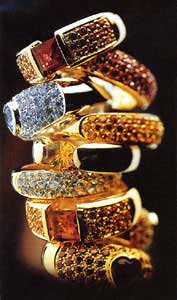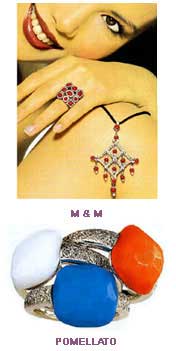
This study analyzes Thailand and its 4 competitor countries, namely China, Hong Kong, India and Italy, with emphasis on the following aspects:
Situation and the Competition
Diamonds
India
has a very high proportion of diamond trade, especially in the US and
Japan markets, leaving far behind its competitors like Hong Kong, Thailand
and Italy. In addition, India has high potential in manufacturing diamonds
smaller than 0.10 karat, and 90% of these small-sized diamonds sold
in the world market are from India. Thus, Thailand should focus more
on cutting medium and larger-sized diamonds to avoid Indian advantage
over abundant and cheap labor.
Thailand is the world center and leading trader of color sapphires. Thailand has a very high potential to compete, especially in the US and Japan markets, due to its expertise in improving color gems, hard gems in particular, and its renowned standpoint in the world market, which result in its highest gems export amount in the world.
Thailand’s major Competitors such as Hong Kong and India in particular, however, are the countries to watch because they have high trade potential, especially in terms of resources.
Synthetic Gems
China has very high proportion of synthetic gems trade in the principal world market, especially the US, while Thailand has higher competition potential, compared to countries like India and Italy that have almost no active role in synthetic gems export.

Thailand is a leading exporter of silver ornament, with higher competition potential than other countries, especially in the US and EU markets. In Japan, however, Thailand’s potential tends to decrease, with Italy on the rise. In addition, China has gained its respect and reserves close monitoring while India and Hong Kong has less active role.
Gold
Owing
much to its manufacturing and exporting capability, Italy has very high
proportion in gold jewelry trade in the world market, except for China
market that trades mainly with Hong Kong. At present, however, Italy’s
competition potential has decreased in the US while Thailand, India, Hong
Kong and China have become stronger.
Imitation Jewelry China is the leading exporter of imitation jewelry in every world principal market. It has higher trade proportion than other countries as well as possesses continuously growing potential in export. India is experiencing the same but total trade volume is not as high, while Thailand has potential in the EU market exclusively, with major competitors such as China and India that follow closely. In other markets, Thailand’s potential tends to diminish. Manufacturing Analysis Countries differ in the way they manufacture gems and jewelry product, depending on the past industrial evolution, industrial structure and supporting industry. For example, India has outstanding diamond cutting and gold jewelry industry because it has been in this for extended period of time; in addition, it is a center of color gems cutting. Italy, by the same token, has long developed its own industrial cluster and designed modern machinery, making its gold jewelry industry a boom. For China and Hong Kong, mixed production technique has been introduced paying attention to unique technique of each country. While Hong Kong is selected to be a base for planning and designing, China is a production host. Moreover, China has started the development of supporting industry, e.g. production of machinery with the quality matching European counterparts but cheaper. |
 |
|
| GERRY WEBER |

Marketing is an important step in adding value to the industry because the investment return is from pricing though system of marketing penetration. Research done on buyer’s attitude over Thai goods is in accordance with data collected on importation of each country, which shows that buyers admire diamonds from India, color gems from Thailand and India, Silver ornament from Thailand, while gold jewelry must be from Hong Kong and Italy.
Regarding product characteristic, buyers seem to be pleased with Italian goods, thanks to its quality, design, brand and the country image. The only disadvantage is high price. While both product from Thailand and Hong Kong are of the same price range and close design, buyers tend to favor the quality of Hong Kong product and brand. Product from India and China are unique in their low price, however, their quality is lower than that of Thai product.
In penetrating the market, India emphasizes on low cost and aggressive marketing strategy at international level. Like India, China uses low cost strategy and broad marketing penetrating. Hong Kong has adopted the concept of brand development and a more aggressive marketing strategy, replacing its traditional low cost emphasis. Italy is the only nation that uses the strategy of differentiation, penetration to selected market group by ways of product itself and type of customers, with focus on premium product.
Role of Government
and Private Sector In the countries where industry is at an advanced stage e.g. Italy and Hong Kong, private sector play an important part in establishing production network and world class exhibition. While the government sector plays minor part in pushing for the search for new markets to assist small-sized business, private sector focus more on trade issue and improvement on education for industry. Thailand and India are similar in the way both countries develop the industry that is to say both government and private sectors are important force in driving production and trade. Indian entrepreneurs are strong in creating world class network, this is why most diamond trade is in the hands of Indian traders. At present, India has more influence than Israel and Belgium. For Thailand, the support from private sector lacks clear marketing strategy, even though close coordination with the government sector exists. China began its free trade policy for gems and ornament following its admission into the World Trade Organization (WTO) e.g. central diamond market and central gold market that are designed to facilitate the sourcing of raw material. This includes the product quality control, consumer protection law and regulation. covering buying, exchanging and repairing the goods. In addition, China has established special economic zone, which can manufacturer and export its product, though co-investment with many countries and possible marketing penetration. |
 |
|||||||||||||||||||||||||
Recommendation
on Strategy for Competition In maintaining Thailand’s potential to compete with others, researchers recommend the following 6 strategies: 1. Strategy for maintaining the Thai market and high potential product e.g. - Improvement of color gems and cutting technique. - Coordination in locating source of raw material. - Systematic improvement of gems quality as well as protection of Thai know-how. 2. Strategy for international communication - More aggressive marketing strategies e.g. participation in major world class exhibition - Promotion of Thai gems and jewelry brand. 3. Strategy for upgrading Thai product at the international market - Supporting manufactures and traders in certifying quality e.g. issuance of product quality certification, engraving to certify warrantee and purity of gold, silver and platinum jewelry, etc. |
||||||||||||||||||||||||||
|
||||||||||||||||||||||||||
